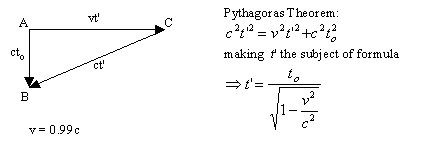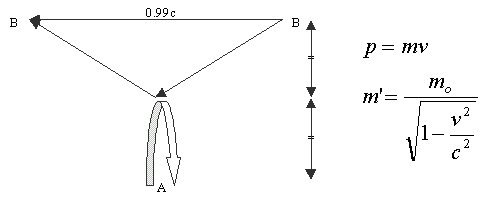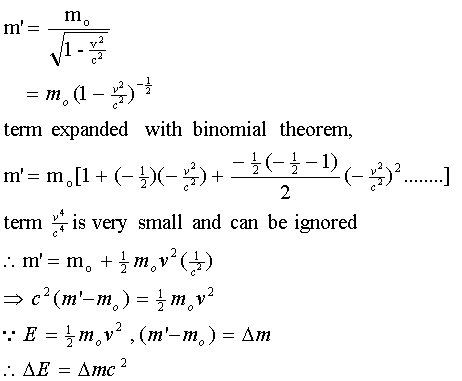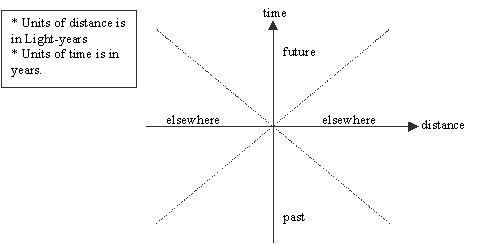
A is a moving observer. B is a stationary observer. A moves to a "freezed" position C. Light has to travel a longer distance from C to reach B, thus t'>to
Time dilation occurs.
| { Foundations, Concepts }------------------------------------------------------------ Geometry |
|
|
|
| Areas covered: | Areas covered: |
| 1) Basic Assumptions | 1) Principle of Equivalence
- Trajectories of Light and Matter - Gravitational Redshift |
| 2) Derived Concepts
- Time Dilation - Contraction of Length - Relativistic Mass Increase |
2) SpaceTime |
| 3) Derivation of E = mc2 | 3) Example of Test of General Relativity ( Deflection of Starlight ) |
| 4) General Theory of Gravitation | |
| 5) Gravitational Waves |
1) Euclidean Geometry
- 2-dimensional geometry
- Sum of interior angles of a plane triangle is
1800
- Through a point not on a given straight line,
only one line can be drawn parallel to the given straight line.
2) Hyperbolic Geometry
- 3-dimensional geometry
- Negatively curved surface
- Sum of interior angles of a triangle is less than
1800
- More than one parallel line can be drawn through
a point parallel to another line.
3) Riemann Geometry ( Elliptical Geometry )
- 3-dimensional geometry
- Positively curved surface
- Sum of interior angles is greater than 1800
- No line can be drawn through a point parallel
to another straight line.
Significance: This part introduces the idea
of 4th dimensional geometry which is analogous to one of these three types.
The 4th dimension being time. It can become the 4th dimension as events
are not simultaneous, meaning time is relative.
Assumptions:
1) No physical experiment can allow one to detect his state of uniform
relative motion.
2) Speed of light is absolute and constant.
- Time is not absolute.
- Time dilation occurs only when the other observer is moving relative
away from you.
Example:

A is a moving observer. B is a stationary observer. A moves to a "freezed"
position C. Light has to travel a longer distance from C to reach B, thus
t'>to
Time dilation occurs.
- Length is not absolute.
- All objects in a moving system, appear foreshortened in the direction
of motion.
Consider an observer A and a triangular object

In order to see triangle, light from it must reach A from 3 corners.
At the "freezed" position, light takes a longer time to travel from the
peak to A than from the base to A. Due to the time difference, the base
has moved forward a bit, so the object appears shortened only in the direction
of motion. As there is no time difference for the base light to travel
to A, there is no shortening.
- Mass is not absolute.
- Conservation of momentum is agreed to be true.

A and B are taken as planes firing a ball of equal rest mass. The balls
collide elastically. Due to time dilation in system B, the vertical component
of velocity of ball B is less than the velocity of ball A. Since momentum
is the same, therefore mass of ball B is greater than mass of ball A.
From Equation of relativistic mass increase:

1) Principal of Equivalence
- A force of gravitation is equivalent to an acceleration of the coordinate
system of the observer, and such a force can therefore be completely compensated
for by an appropriate choice of an accelerated coordinate system.
Trajectories of Light and Matter
- No physical experiment can allow one to detect his state of uniform
relative motion.
Gravitational Redshift
- Radiation climbing upward in a gravitational field should show a
observable redshift.
- ( Analogy ) In a lift, when it accelerate downwards, a light is shone
from the floor to the ceiling. The ceiling is moving towards the source,
thus a blueshift is experienced, but since one is unable to detect his
own absolute motion, so a redshift due to the light moving upward against
gravity that exactly compensates the blueshift is experienced.
- Events are not simultaneous in space-time.
- Gravitational field varies, space-time must be curved.
- Gravitational field varies with the distribution of matter.
- Space-time is the system of coordinates that is used to describe the motions of objects and light.
- 3-dimensional geometry is used to describe curved space-time.

- Starlight just grazing the Sun's surface will be deflected by an angle of 1".75.
- On May 29 1919, an eclipse occurs and stars near the Sun are photographed. Stars seen near the Sun were displaced and to the accuracy of the measurements, the shifts were consistent with the predictions of relativity.

- According to Einsteinian interpretation, each mass is said to produce a field in the space surrounding it, wherein time is slowed down and light passing through the space is curved.
- Each elementary particle creates a space-time curvature in direct proportion to the mass and in inverse proportion to the square of the distance from the particle.
- In contrast to Newton's Law, distance from particle is not taken to be point mass.
Famous Quote: Mass tells space how to curve, space tells mass how
to move.
(Note: Once you understand this statement, theory of relativity is
much easier to understand.)
- Since geometry of spacetime depends on the distribution of matter, any rearrangement of matter must result in an alteration of spacetime. A disturbance is created. Relativity predicts that the disturbance should propagate through space with the speed of light, called a gravitational wave.
- Gravitational Waves will set material objects vibrating, but the amplitude is too small to be detected.
